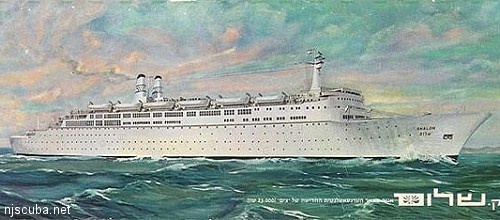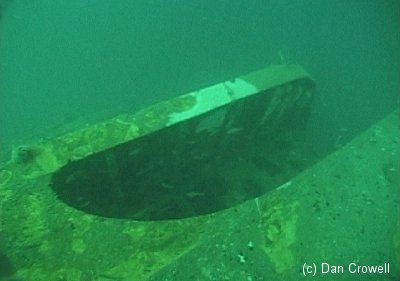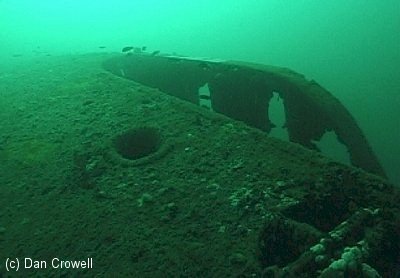Stolt Dagali (1/4)

- Type:
- shipwreck, tanker, Norway
- Name:
- Stolt is the name of the line that owned the ship; it translates "proud". Dagali is a mountain valley in Norway.
- Built:
- 1955, Denmark, as Dagali
- Specs:
- ( 582 x 70 ft ) 12723 gross tons, 43 crew
- Sunk:
- Thursday November 26, 1964 ( Thanksgiving day )
collision with liner Shalom ( 25,338 tons ) - 19 casualties - Depth:
- 130 ft, starts at 60 ft


By all accounts, the brand-new liner Shalom was proceeding at a recklessly fast pace through a thick fog, while simultaneously misreading her radar set. The slow-moving M-class tanker Stolt Dagali was sliced clean through, losing almost half her crew when the heavy stern section plummeted to the bottom of the sea. Fortunately, the Stolt carried a cargo of non-flammable vegetable oil, otherwise, both vessels might have been consumed in flames. The bow section of the Stolt was salvaged, while the stern section lies crookedly on its starboard side, 142 ft long in 130 ft of water. Survivors of the Stolt were picked up by the Cape Straight.

The wreck of the Stolt is very impressive, even though now greatly deteriorated. Compared to the sketch below, the smokestack, mast, and much of the upper works have fallen away. Not shown is the large debris field around the wreck. Visibility is usually good, sometimes good enough to see the top of the wreck from the surface, and the sight of this huge wreck when it first looms into view as you descend the anchor line is extraordinary. There is something awesome about this shipwreck that is somehow lacking in the nearby planned artificial reefs.

The Stolt Dagali has collapsed considerably, losing its funnel and settling by the stern since this fine drawing was made in 1982. Here are some of the artist's comments on this illustration:
- When I did that illustration, the Stolt's stack was still in place. The "S" was still visible through the marine growth. On many a dive out there the stack cast it's shadow on the sand below. ( That is what the dark area to the left of the stack is supposed to depict. )
- When this illustration was done, the high point on the wreck was the area situated closed to the two (smaller) divers in the distance ( closest to the wreck. ) the high point was the port-side railing area close to the break, ( just to the left of the three portholes to the left of the "little" divers. The two (larger) divers are closer to the viewers viewing point which is the furthest from the wreck and relatively close to the surface ! That area behind ( or below ) the larger divers is where the Shalom cut through the Stolt, and the plates are bent, twisted and pushed over from port to starboard.
- As for the angle at which it was drawn, I chose a somewhat three-quarter viewing angle. I wanted to present the Stolt at the approximate angle at which it lies. This could not be done with a view from above. Now would a "head-on" view be able to present the Stolt's many facets and levels of diving areas.
- It is important to note that all illustrations of shipwrecks are a depiction of that particular wreck "at a given moment in time". All shipwrecks will, and do, change as time moves on and the sea conditions that affect the area in which that particular wreck lies. This illustration was an accurate representation of the site at the time it was made !
-- Chuck Zimmaro Cpzimmaro@aol.com, 2003

The port side of the ship is now the top of the wreck. On one side the smooth hull slopes down into the depths. This area is very reminiscent of a Caribbean wall dive ( minus the coral, ) as this surface is covered with hydroids and anemones of various colors, encrusting sponges, mussels, and swarms of fish against a background of bright orange rust. At one end the curve of the stern is unmistakable, while the other end of the wreck, where the ship was severed, is just a jumbled mess. The fourth wall of the wreck is formed by the aft superstructure, sticking out sideways from the former deck. This area is slowly opening up and collapsing, and there are huge interior spaces with wide openings that may be easily penetrated.
The propeller lies half-buried in the sand, while the broken-off rudder lies nearby, pretty much where you would expect it. Drop straight down from the fantail over the smooth curve of the hull along the east side to get there. To get to the fantail, follow the top of the wreck north to where everything drops off from about 80 ft to over a hundred.



The Stolt would be one of the largest shipwrecks in the region if the whole ship was there, but as it is barely big enough for two dive boats to share. It is also not the easiest wreck to anchor to; often the hook just slides over the smooth hull with nothing to catch on to. At these times, the Algol in the nearby Shark River Artificial Reef becomes a strong attraction, with all of its intact railings and edges. More than once I have set out on the long ride to the Stolt, only to end up on the Algol again.


Here's a spot that anyone can find - the very highest point on the wreck. At this spot, my depth gauge read 55 ft. You can see how the rail was bent 90 degrees in the collision - the proper line of the hull runs from lower-left to upper-right, stern to bow.
This is one of the only true multi-level dives in the area. A beginner can have a fine dive around the top of the wreck at 70 ft, while more advanced divers can do considerable exploration and still stay above 100 ft, and real nitrogen-lovers can poke around in the sand down to 130 ft. The Stolt produces lobsters, mussels, and artifacts from the surrounding debris field and the interior.

Thought you might be interested in the enclosed photos. I took these shortly after the collision. It was perhaps the second dive on the wreck. Rollimarin with Rolliflex camera. Dead calm, visibility about 70 feet, temp about 37-38 deg. F.

Courtesy of Jack C. Sofield










Courtesy of Dan Crowell




The Stolt Lady was created in 1965 from the stern of the CT Gogstad and the bow of the Stolt Dagali. In 1974 she was renamed Lido and apparently worked the Great Lakes. Then she was the Fleurtje in '75, where I don't know. After that, apparently still in '75, she was reconstructed into the Matthias III, a chemical incineration ship. The "Frankenstein" feature jutting from the aft superstructure is actually a smokestack. The final conversion was not considered a success.
-- Dan Bentley


Questions or Inquiries?
Just want to say Hello? Sign the .